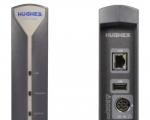Meteorological instruments. Meteorological instruments - instruments and installations for measuring and recording the values of meteorological elements. For comparison. Modern meteorological instruments
Nastich Nadezhda Valentinovna
Thermometer
Thermometer is a device for measuring the temperature of air, soil, water, and so on. There are several types of thermometers:
-
infrared.
liquid;
mechanical;
electronic;
optical;
Psychrometer
A psychrometer is a device for measuring air humidity and temperature. The simplest psychrometer consists of two alcohol thermometers. One thermometer is dry, and the second has a humidification device. The alcohol flask of a wet thermometer is wrapped in cambric tape, the end of which is in a vessel with water. Due to the evaporation of moisture, the moistened thermometer cools.
Barometer
Barometer is a device for measuring atmospheric pressure. The mercury barometer was invented by the Italian mathematician and physicist Evangelista Torricelli in 1644; it was a plate with mercury poured into it and a test tube (flask) placed with the hole down. When atmospheric pressure increased, the mercury in the test tube rose, and when it decreased, the mercury fell.
Mechanical barometers are usually used in everyday life. There is no liquid in the aneroid. Translated from Greek, “aneroid” means “without water.” It shows the atmospheric pressure acting on a corrugated thin-walled metal box in which a vacuum is created.
Anemometer
Anemometer, wind meter - a device for measuring the speed of movement of gases and air in systems, for example, ventilation. In meteorology it is used to measure wind speed.
Based on the principle of operation, mechanical anemometers, thermal anemometers, and ultrasonic anemometers are distinguished.
The most common type of anemometer is the cup anemometer. Invented by Dr John Thomas Romney Robinson, who worked at the Armagh Observatory, in 1846. It consists of four hemispherical cups, symmetrically mounted on the cross-shaped spokes of a rotor rotating on a vertical axis.
Wind from any direction rotates the rotor at a speed proportional to the wind speed.
Precipitation gauge
A precipitation gauge, rain gauge, pluviometer or pluviograph is a device for measuring atmospheric liquid and solid precipitation.
The device of the Tretyakov precipitation gauge
The precipitation gauge set consists of two metal vessels for collecting and storing precipitation, one lid for them, a tagan for installing precipitation vessels, wind protection and two measuring cups.
Pluviograph
A device designed for continuous recording of the amount and intensity of liquid precipitation with reference to time (beginning of precipitation, end, etc.), and on modern weather vanes - using an electronic device.
A weather vane often serves as a decorative element to decorate a home. The weather vane can also be used to protect the chimney from blowing out.
METEOROLOGICAL INSTRUMENTS- instruments and installations for measuring and recording the physical characteristics of the earth’s atmosphere (temperature, air pressure and humidity, wind speed and direction, cloudiness, precipitation, atmospheric transparency), as well as water and soil temperature, solar radiation intensity, etc. Using M. items are detected and assessed by physical. processes that cannot be perceived directly, and also conduct scientific research. MPs are used in various fields of science and technology and in many sectors of the national economy.
In medical-biological practice, microclimates are used to study and assess the climate of individual areas, as well as the microclimate of residential and industrial buildings.
The first measuring instrument was created in India more than 2 thousand years ago to measure the amount of precipitation, but regular measuring instruments began to be used only in the 17th century. after the invention of the thermometer and barometer. In Russia there are systematic climatol. instrumental observations have been carried out since 1724.
Depending on the method of recording data, recordings are divided into indicating and recording. With the help of indicating micrometers, visual data is obtained, which, through the reading devices available in these devices, makes it possible to determine the values of the measured quantities. Measuring instruments include thermometers, barometers, anemometers, hygrometers, psychrometers, and others. Recording instruments (thermographs, barographs, hygrographs, etc.) automatically record readings on a moving paper tape.
The temperature of air, water, and soil is measured by liquid thermometers - mercury and alcohol, bimetallic, as well as electric thermometers, in which the primary perception of temperature is carried out through sensors (see) - thermoelectric, thermoresistive, transistor and other converters (see Thermometry). Temperature is recorded using thermographs, as well as thermoelectric converters connected (including remotely) to recording devices. Air humidity is measured by psychrometers (see) and hygrometers (see) various types, and hygrographs are used to record changes in humidity over time.
Wind speed and direction are measured and recorded using anemometers, anemographs, anemorumbometers, weather vanes, etc. (see Anemometer). The amount of precipitation is measured by precipitation gauges and rain gauges (see Rain gauge), and recorded by pluviographs. Atmospheric pressure is measured by mercury barometers, aneroids, hypsothermometers, and recorded by barographs (see Barometer). The intensity of solar radiation, radiation from the earth's surface and atmosphere is measured by pyrheliometers, pyr-geometers, actinometers, albedometers, and recorded by pyranographs (see Actinometry).
Remote and automatic medical devices are becoming increasingly important.
Bibliography: Meteorological instruments and automation of meteorological measurements, ed. L. P. Afinogenova and M. S. Sternzata, Leningrad, 1966; Reifer A. B. et al. Handbook of hydrometeorological instruments and installations, L., 1976.
V. P. Padalkin.
Questions before the paragraph.
1. What is called the atmosphere?
The atmosphere is the air envelope of the Earth.
2. What gases does air consist of?
The Earth's air mainly consists of nitrogen molecules (78%). Its second component is oxygen, which makes up about 21% of air. The remaining 1% comes from other gases - carbon dioxide, ozone, and inert gases.
3. What device measures atmospheric pressure?
A device for measuring atmospheric pressure is called a Barometer.
4. What signs of weather changes do you know?
Changes in atmospheric pressure: When the weather changes from clear to stormy, the pressure drops for several days. Increased wind, increased cloudiness.
5. What specialists study the atmosphere?
A meteorologist studies the atmosphere.
Geographer-Pathfinder School
The task is a project activity and requires independent work.
Questions and tasks after the paragraph.
1. Define weather in your own words.
The state of the atmosphere in a certain place at a certain time.
2. Is it possible to talk about the weather over the course of a day or a week?
We can talk about the weather within a day or a week with almost 100% accuracy, but the longer the weather forecast, the more likely the forecast is inaccurate, because the weather is constantly changing, and therefore the weather forecast is constantly being adjusted.
3. Why are meteorological stations organized?
meteorological stations are organized to collect information about air temperature and humidity, atmospheric pressure, wind direction and speed, the amount and types of clouds and precipitation, and atmospheric phenomena that can be dangerous to humans.
4. Take a trip to the nearest weather station.
An excursion is expected to take place with the class or parents.
5. Complete the sentences with the names of the properties of air.
A barometer measures air pressure.
The hygrometer shows the temperature and humidity of the air.
A thermometer can measure air temperature.
The weather vane indicates where the wind is blowing from and at what speed.
6. Write a short story about meteorological instruments. Find out additional information about them from encyclopedias or the Internet.
The main instrument for measuring wind direction and speed is the M-63M-1 anemormbometer. In the event of a power failure or failure of the device, a Wild weather vane with a light board serves as a backup device for visual assessment of wind characteristics. To measure the amount of precipitation (mm), the Tretyakov Precipitation Gauge is used. The intensity of liquid precipitation is recorded using a recorder called a Pluviograph. The shape and number of clouds in points are determined visually and compared with photos using the international Cloud Atlas. The height of the cloud base is determined using a cloud height meter (CHM). The meteorological visibility range is monitored using landmarks using an M-53A polarization visibility meter. The duration of sunshine is determined by a heliograph, the glass ball of which collects the sun's rays into focus, and when the beam moves, a burn line appears on the tape. The length of the line in hours is used to calculate the duration of sunshine. The depth of soil freezing is measured using a permafrost meter.
7. Compare the readings of meteorological and mercury medical thermometers. Analyze the result obtained during the observation.
Thermometer readings vary. A medical mercury thermometer shows a lower temperature.
8. Prepare a report on modern meteorological instruments used in everyday life (aneroid barometer, electronic thermometer, digital weather stations).
An aneroid barometer is a device whose operating principle is based on changing the size of a metal box filled with rarefied air under the influence of atmospheric pressure. Such barometers are reliable and small in size.
An aneroid barometer is a device designed to measure atmospheric pressure mechanically. Structurally, the aneroid consists of a round metal (nickel-silver or hardened steel) box with corrugated (ribbed) bases, in which a strong vacuum is created by pumping out air, a return spring, a transmission mechanism and an indicator needle. Under the influence of atmospheric pressure: its increase or decrease, the box, respectively, either compresses or unbends. In this case, when the bellows box is compressed, the upper flexing surface begins to pull the spring attached to it down, and when the atmospheric pressure decreases, the upper part, on the contrary, bends and pushes the spring upward. An indicator needle is attached to the return spring using a transmission mechanism, which moves along a scale calibrated in accordance with the readings of the mercury barometer (Figure 2). It is worth noting that usually, in practice, several (up to 10 pieces) thin-walled corrugated boxes with vacuum are used in series, which increases the amplitude of the pointer moving along the scale.
Figure 2. Aneroid Barometer structure
Aneroid barometers, due to their small size and the absence of liquid in their design, are the most convenient and portable; they are widely used in practice.
Unfortunately, barometers are affected by temperature environment and changes in spring elasticity over time. Therefore, modern aneroid barometers are equipped with an arc-shaped thermometer, or a so-called compensator, which is intended to correct the instrument readings for temperature.
Aneroid barometer M-67 is the most accurate and unpretentious barometer. Thanks to its design features, it is capable of operating at temperatures from -10 to +50 °C (Figure 3).
Thermometer is a device for measuring the temperature of air, soil, water, and so on. There are several types of thermometers:
Liquid;
Mechanical;
Electronic;
Optical;
Gas;
Infrared.
Operating principle electronic thermometers based on changes in conductor resistance with changes in ambient temperature.
A wider range of electronic thermometers are based on thermocouples (contact between metals with different electronegativity creates a contact potential difference that depends on temperature).

The most accurate and stable over time are resistance thermometers based on platinum wire or platinum coating on ceramics. The most widely used are PT100 (resistance at 0 °C - 100Ω) PT1000 (resistance at 0 °C - 1000Ω) (IEC751). The dependence on temperature is almost linear and obeys a quadratic law at positive temperatures and a fourth-degree equation at negative temperatures (the corresponding constants are very small, and to a first approximation this dependence can be considered linear). Temperature range −200 - +850 °C.
A digital weather station is a portable device that receives weather reports via a special radio channel. The device is equipped with a large electronic display; the screen displays the temperature outside the window in the “here and now” mode, as well as the forecast for the next day. In addition, the device shows the level of humidity and atmospheric pressure, in some cases the condition of roads and the forecast of magnetic storms. Modern weather stations are digital wireless devices that also determine the degree of radiation pollution in the area, as well as the phases of the moon, the level of solar activity and the favorable conditions for agricultural work. In fact, all the information that a digital weather station provides can be obtained from other sources - radio and television broadcasts, news sites and mobile phone applications.
















1 of 15
Presentation on the topic: Meteorological instruments
Slide no. 1

Slide description:
Slide no. 2

Slide description:
Meteorological instruments are designed to operate in natural conditions in any climatic zone. Therefore, they must work flawlessly, maintaining stable readings in a wide range of temperatures, high humidity, precipitation, and should not be afraid of large wind loads and dust. To compare the results of measurements made at different weather stations, meteorological instruments are made of the same type and installed so that their readings do not depend on random local conditions.
Slide no. 3

Slide description:
Meteorological thermometer Maximum meteorological thermometer. Mercury glass thermometer for determining the maximum temperature over a period of time. Manufactured according to GOST 112-78. It is included in the State Register of Measuring Instruments and has a certificate “approving the type of measuring instruments”. Specifications: Brand TM-1, Temperature measurement range -35...+50 ºC, Scale division - 0.5 ºC, Thermal. Liquid 18.0±1 Design Glass thermometer with an embedded scale plate made of milky sheet glass. It has a special device that prevents the mercury column from falling during cooling, which allows you to record the maximum temperature for a certain period of time.
Slide no. 4

Slide description:
Psychro meter Psychro meter (ancient Greek Ψυχρός - cold) also. A psychrometric hygrometer is a device for measuring air humidity and temperature. The simplest psychrometer consists of two alcohol thermometers, one is a regular dry thermometer, and the second has a humidification device. Thermometers have precise graduations with division values of 0.2-0.1 degrees. The temperature sensor of a wet bulb thermometer is wrapped in cotton cloth, which is placed in a container of water. Due to the evaporation of moisture, the moistened thermometer cools. To determine relative humidity, readings are taken from dry and wet thermometers, and then a psychrometric table is used. Typically, the input values in a psychrometric table are the dry-bulb readings and the temperature difference between the dry and wet bulbs. Modern psychrometers can be divided into three categories: station, aspiration and remote. In station psychrometers, the thermometers are mounted on a special stand in the meteorological booth.
Slide no. 5

Slide description:
Hygrometer A device for measuring air humidity. There are several types of hygrometers, the action of which is based on different principles: weight, hair, film, etc. A film hygrometer has a sensitive element made of an organic film, which stretches when humidity increases and contracts when humidity decreases. The change in the position of the center of the film membrane 1 is transmitted to arrow 2. In winter, a film hygrometer is the main instrument for measuring air humidity.
Slide no. 6

Slide description:
Hygrograph Hygrograph (ancient Greek ὑγρός - wet and γράφω - writing) is a device for continuous recording of relative air humidity. The sensitive element of the hygrograph is a bunch of defatted human hair or an organic film. The recording takes place on a graphed tape placed on a drum rotated by a clock mechanism. Depending on the duration of the drum rotation, hygrographs are either daily or weekly.
Slide no. 7

Slide description:
Barometer Barometer is a device for measuring atmospheric pressure. The most common are: liquid barometers, based on balancing atmospheric pressure with the weight of a liquid column; deformation barometers, the operating principle of which is based on elastic deformations of the membrane box. The most accurate standard instruments are mercury barometers: due to its high density, mercury makes it possible to obtain a relatively small column of liquid in the barometer, convenient for measurement. Mercury barometers are two communicating vessels filled with mercury; one of them is a glass tube about 90 cm long sealed at the top and containing no air. The measure of atmospheric pressure is the pressure of a column of mercury, expressed in mm Hg. Art. or in mbar.
Slide no. 8

Slide description:
Aneroid (from the Greek a - negative particle, nērys - water, i.e. acting without the help of liquid) Aneroid barometer, a device for measuring atmospheric pressure. The receiving part of the aneroid is a round metal box with corrugated bases, inside of which a strong vacuum is created. When atmospheric pressure increases, the box contracts and pulls the spring attached to it; when the pressure decreases, the spring unbends and the upper base of the box rises. The movement of the end of the spring is transmitted to a pointer moving along the scale. An arc-shaped thermometer is attached to the scale, which serves to correct the temperature readings.
Slide no. 9

Slide description:
Actinometer Actinometer (from the Greek ακτίς - ray and μέτρον - measure) - meter, which serves to measure the intensity of electromagnetic radiation, mainly visible and ultraviolet light. In meteorology, it is used to measure direct solar radiation. An actinometer is also a name given to instruments that measure the amount of radiant heat emitted into celestial space.
Slide no. 10

Slide description:
Albedometer Albedometer is a device for measuring albedo. It works on the principle of an integral ball photometer. The albedo of the earth's surface is measured with a pass-through albedometer - two connected pyranometers, the receiving surface of one of which is turned towards the ground and perceives scattered light, the second - towards the sky and registers the incident radiation. They also use one pyranometer, the receiving surface of which rotates up and down.
Slide no. 11

Slide description:
Anemometer Anemometer is a device for measuring wind speed. Based on the design of the receiving part, there are two main types of anemometers: a) cup anemometers - for measuring the average wind speed of any direction within the range of 1-20 m/s; b) winged - for measuring the average speed of directed air flow from 0.3 to 5 m/s. Vane anemometers are mainly used in pipes and ducts of ventilation systems. Three-dimensional ultrasonic anemometer The operating principle of ultrasonic anemometers is to measure the speed of sound, which changes depending on the direction of the wind. There are two-dimensional ultrasonic anemometers, three-dimensional ultrasonic anemometers and hot-wire anemometers. The 2D anemometer is capable of measuring the speed and direction of horizontal wind. A three-dimensional anemometer measures primary physical parameters - pulse travel times, and then converts them into three components of wind direction. The hot-wire anemometer, in addition to three components of wind direction, is also capable of measuring air temperature using the ultrasonic method.
Slide no. 12

Slide description:
Hypsothermometer (from the Greek hýpsos - height) is a device for measuring atmospheric pressure by the temperature of a boiling liquid. The boiling of a liquid occurs when the elasticity of the vapor formed in it reaches the external pressure. By measuring the temperature of the steam of a boiling liquid, the value of atmospheric pressure is found using special tables. The hypsothermometer consists of a special thermometer 1, which allows you to read the temperature with an accuracy of 0.01°, and a boiler, which consists of a metal vessel 3 with distilled water and a sliding tube 2 with double walls. The thermometer is placed inside this tube and washed with steam from boiling water. Hypsothermometers are produced in which the divisions on the thermometer scale are marked in pressure units (mm Hg or mb).
Slide description:
Electrometer Mechanical electrometers are now used almost exclusively for educational purposes. They were widely used in science and technology back in the first third of the 20th century (in particular, in studies of radioactivity and cosmic rays, the rate of charge loss caused by ionization of air by ionizing radiation was measured using electrometers). Modern electrometers are electronic voltmeters with a very high input resistance, reaching 1014 ohms.
Slide no. 15

Slide description:
Weather vane (Dutch Vleugel) is a meteorological instrument for measuring the direction (sometimes speed) of the wind. A weather vane is a metal flag located on a vertical axis and rotating under the influence of the wind. The flag's counterweight is directed in the direction from which the wind is blowing. The direction of the wind can be determined by horizontal pins oriented along eight-point lines, and on modern weather vanes - using an electronic device (encoder).
To use presentation previews, create an account for yourself ( account) Google and log in: https://accounts.google.com
Slide captions:
Meteorological instruments
Thermometer Thermometer is a device for measuring the temperature of air, soil, water, etc.
Barometer Barometer is a device for measuring atmospheric pressure.
Hygrometer A hygrometer is a device for measuring the humidity of air or other gases.
Precipitation gauge A precipitation gauge is a device for collecting and measuring the amount of precipitation. The precipitation gauge is a cylindrical bucket of a strictly defined cross-section, installed at the weather site. The amount of precipitation is determined by pouring the precipitation that fell into the bucket into a special rain gauge glass, the cross-sectional area of which is also known. Solid precipitation (snow, pellets, hail) is preliminarily melted.
Snow measuring staff Snow measuring staff is a staff designed to measure the thickness of snow cover during meteorological observations.
Thermograph A thermograph is a recorder device that continuously records air temperature and records its changes in the form of a curve. The thermograph is located at the weather station in a special booth.
Heliograph A heliograph is a recorder device that records the duration of sunshine.
Nephoscope Nephoscope is a device designed to determine the relative speed of movement of clouds and the direction of their movement.
Anemometer Anemometer is a device for measuring wind speed and gas flows by the number of revolutions of a turntable rotating under the influence of the wind.
Blizzard meter Blizzard meter is a device used to determine the amount of snow carried by the wind.
Meteorological satellite A meteorological satellite is an artificial Earth satellite that records and transmits various meteorological data to Earth.
On the topic: methodological developments, presentations and notes
Summary of an open lesson on table etiquette on the topic: ...
Presentation is a game for classes to familiarize yourself with the surrounding world and ecology: “What was and what is”...
Scenario plan for direct educational activities Direction of activity: “Social and personal” Dominant educational area “Socialization”. Topic: “Co...
"Kingdom of Cutlery"
Expand knowledge about table setting and cutlery. To form an aesthetic attitude towards table setting, to practice the ability to decorate the table. Continue to strengthen the ability to maintain correct...




